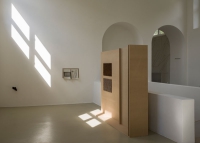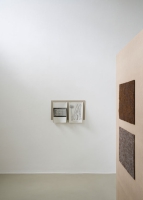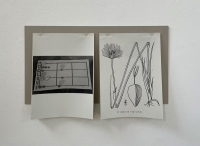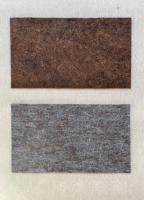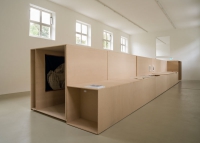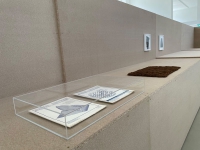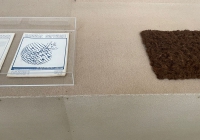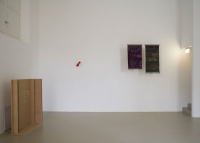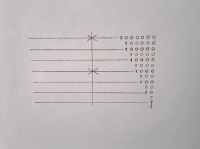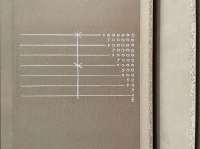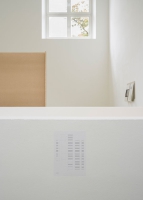„Mache für Dich Linihen…“ (Make lines for yourself)
Letter 03 (Kunstverein München), 2024
Felting the Eriophorum vaginatum
for the show "Key Operators - Weaving and Coding as languages of feminist historiography"
Kunstverein München
.
6 pieces, each 40 x 70 cm
Spatialized in correspondence with Element A-D by Johannes Porsch
Burre 01
Needle felt, dry felt by Dorothee Goerke
Cleaned peat fibre by Torffaser Atelier Lenzburg, Carded sheep wool
Burre 02
Walk felt, wet felt by Dorothee Goerke
Cleaned peat fibre by Wandil Torfmanufaktur, Carded sheep wool
Peat fibres are mummified remnants of the cottongrass (Eriophorum vaginatum) that grows in bogs
Burre 03
Source material
Print-outs, bookbinding cardboard
Burre 04
Raw material
Cleaned peat fibre by Wandil Torfmanufaktur
Burre 05
Computing lines after Adam Ries, 1550
Sanguine, drawn by Jonah Gebka
Burre 06
Computing lines after Adam Ries, 1550
Chalk, drawn by Jonah Gebka
.
For Key Operators, Mayer has conceived a new multi-part work, that furthers her research into the connections between women who compute and textiles. This narrative, however, does not begin in the mid-19th century with Ada Lovelace, the Analytical Engine, and the Jacquard loom, as it otherwise usually would, but in the Middle Ages with a plant that grows in swamps and goes by the name of “bur.” Decaying parts of this plant would be matted into fibers from which a felt was made. This fabric was called “burre” and was often crafted into monks’ robes, book bindings, or underlays for documents and writing utensils in monasteries. The material was also used to fabricate so-called calculating cloths, a portable form of the counting table or abacus. The cloth can therefore be regarded as the first mobile calculator of sorts. Etymologically, its name transformed into the term “bureau” to describe the soft pad, and from there extended to the room in which the table stood: this room became the “bureau,” the office.(1)
In collaboration with Dorothee Goerke, Mayer developed textile applications for the exhibition that enter into a dialog with the niches and notches of the display of Johannes Porsch. Here, she establishes a connection to a significant rethinking of the relation between architecture and textiles undertaken by Anni Albers. As a “counterpart to solid walls,” Albers refers to interstices or hinges as textile elements and thereby renegotiates the gender-political inscriptions in the material.(2) Mayer takes up the concept of such mobile, nomadic structures by installing her works on both “the smooth and the striated spaces” within the institution.(3)
(1) See Gloria Meynen, “Büro,” Dissertation, Department of Philosophy, Humboldt-Universität zu Berlin, 2004.
(2) See Anni Albers, “The Pliable Plane: Textiles in Architecture,” in: Perspecta: The Yale Architectural Journal, no. 4, 1957, pp. 36–41.
(3) See Gilles Deleuze & Félix Guattari, A Thousand Plateaus: Capitalism and Schizophrenia, trans. Brian Massumi (Minneapolis: University of Minnesota Press, 1987).
.
Reviews:
Christina Irrgang, Elektrisierende Verbindungen, Texte zur Kunst:
https://www.textezurkunst.de/en/articles/christina-irrgang-key-operators-elektrisierende-verbindungen/
Carmela Thiele, Holzschuhe ins Getriebe werfen, taz:
https://taz.de/Kunst-ueber-Coding-und-Feminismus/!6038491/
Carmela Thiele, Vom Rechentuch zum Bildschirm: Programmieren und Weben als Thema der Kunst, RiffReporter: https://www.riffreporter.de/de/technik/kunst-wissenschaft-programmierte-gedichte-gewebte-chip-modelle
.
Photos: Katrin Mayer and Maximilian Geuter / Kunstverein München
.
.
